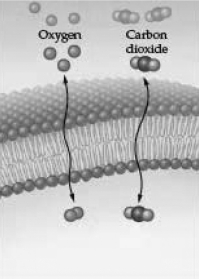Multiple Choice
What best explains the double-headed arrows associated with carbon dioxide and molecular oxygen shown in the following illustration? 
A) Individual molecules are unable to cross the membrane, but they can be found in relatively large numbers on both sides.
B) The membrane is permeable to these small molecules and they enter or leave rapidly as their concentration gradients change.
C) An isotonic condition exists for each molecule, so no net movement takes place.
D) Homeostasis requires that surplus molecules entering the cell be rejected and returned to the outside.
Correct Answer:

Verified
Correct Answer:
Verified
Q23: Cells suspended in a hypertonic solution will
Q24: If a red blood cell is placed
Q25: Which of the following is found in
Q26: Many hormones are large and hydrophilic.Where would
Q27: Which of the following types of molecules
Q29: Elevated cholesterol and LDL (the particles that
Q30: Several types of lipoproteins exist; the best
Q31: All movement,including that of diffusing molecules,requires a
Q32: When the solute concentration outside a cell
Q33: Receptors in target cells can be located